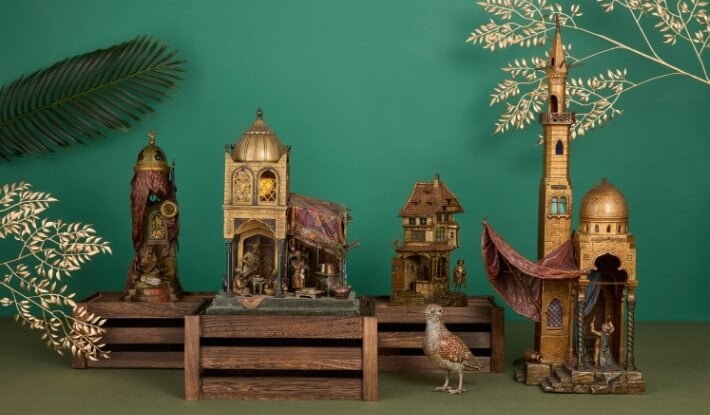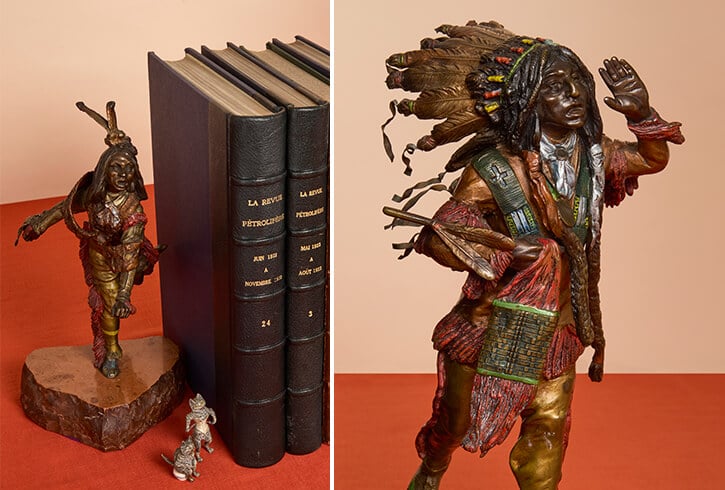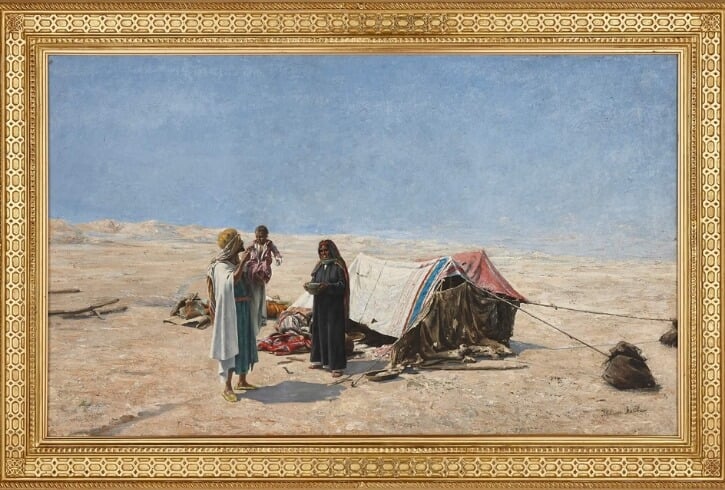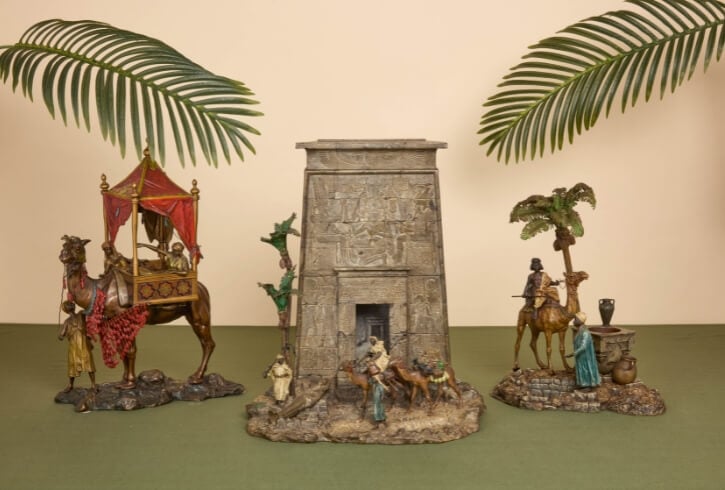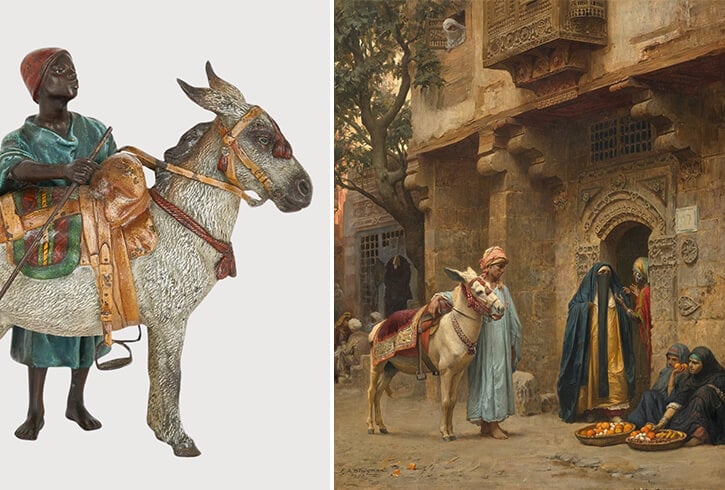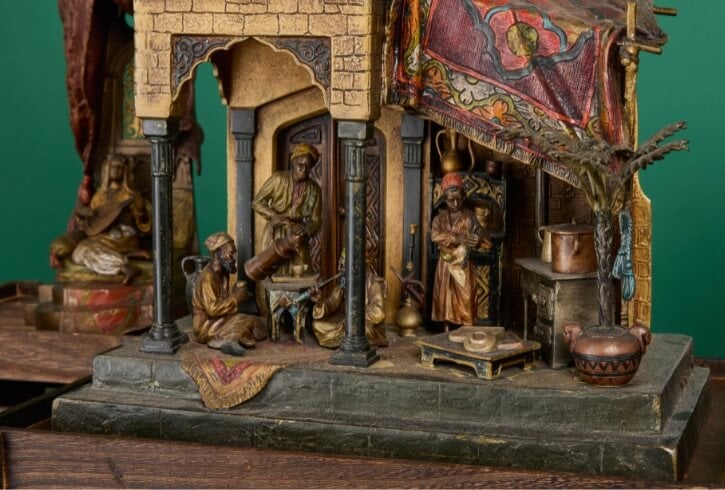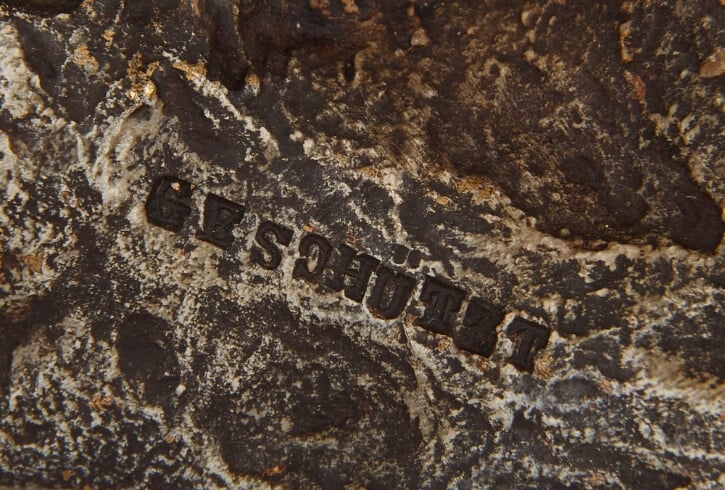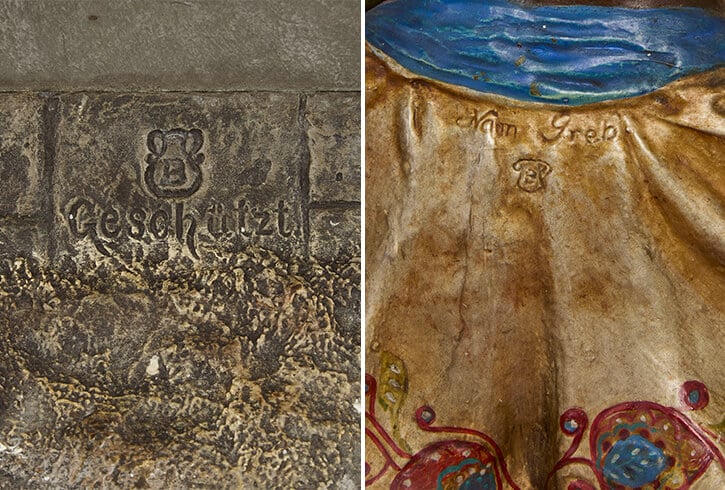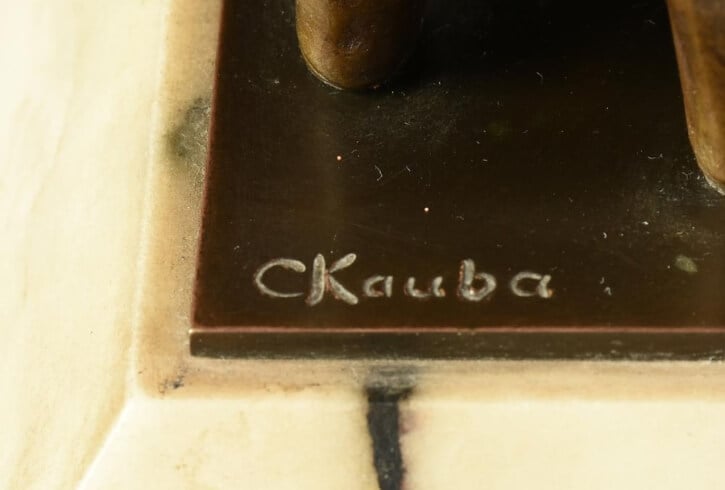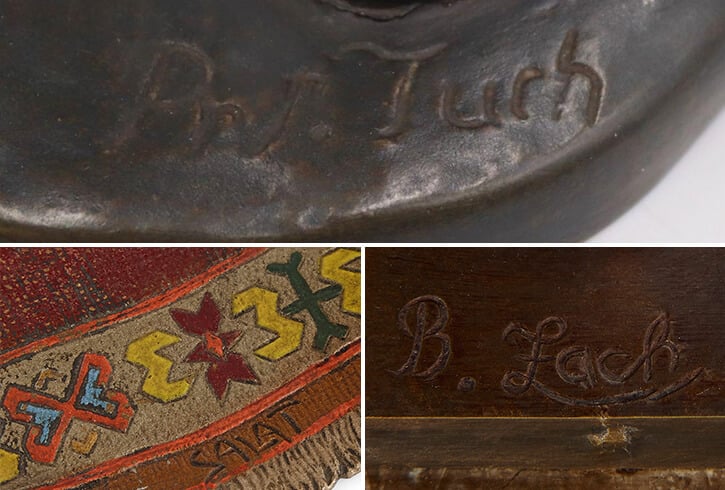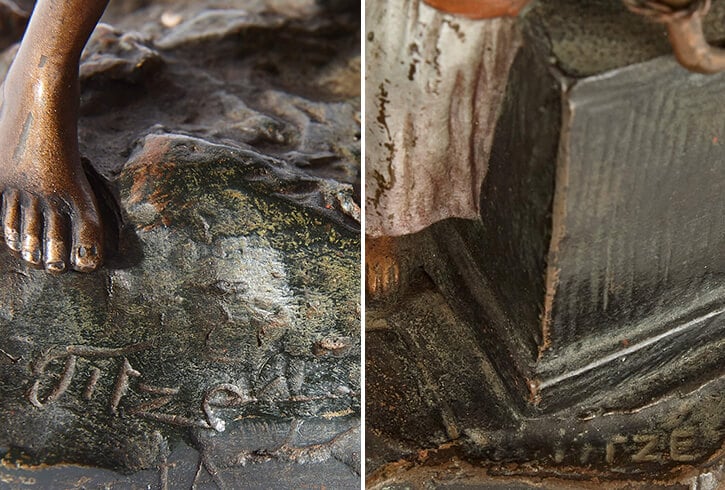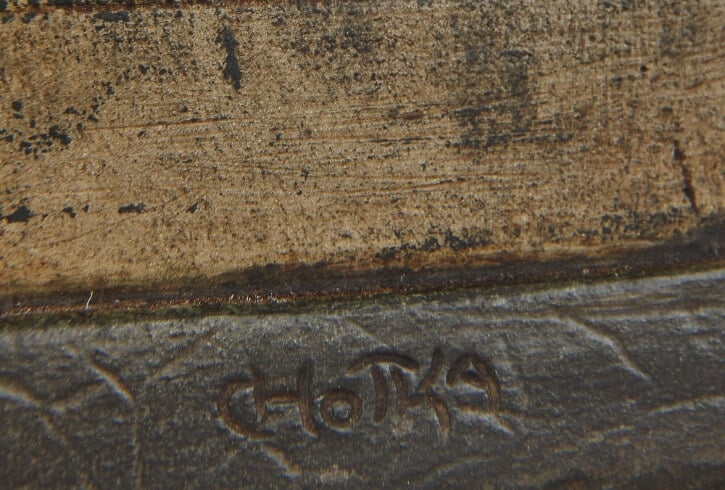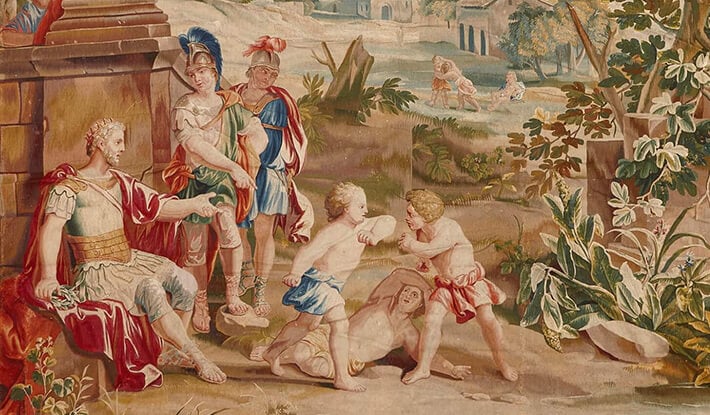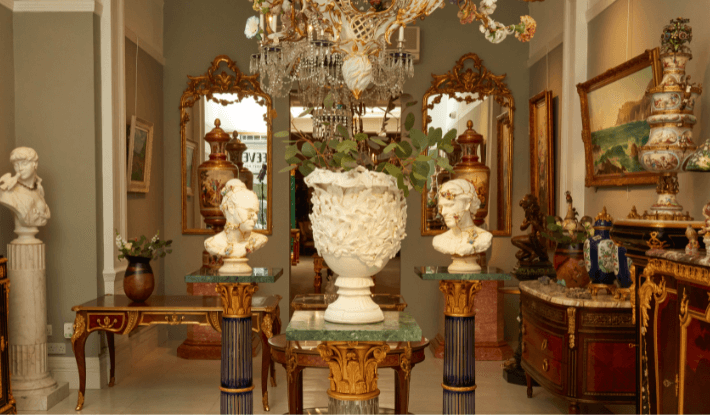At the turn of the 20th century, Vienna was an undeniable cultural hub, where a plethora of makers were producing high-quality goods. One such product was the cold-painted bronze: born in Vienna, these sculptures have become renowned worldwide for their superb finish and interesting designs. These bronze models, which ranged from decorative miniatures to larger functional wares, held great appeal for the growing upper-middle classes in Europe, who would proudly display these pieces in their bourgeoise interiors.
How were Viennese cold-painted bronzes crafted? Who produced them? What do they depict? Read on to find out the answers to all these questions and more!
What are cold-painted Vienna bronzes?
The practice of cold-painting bronze sculptures emerged from the Viennese bronze industry, which flourished during the Biedermeier era (1815-1848), with sculptures quickly becoming renowned for the high standard of finish, the realistic depictions of the subjects and the playful designs. Whilst these bronzes were crafted with various finishes, it was the ones decorated with the unusual cold-painting technique that proved to be some of the most iconic.
As the name suggests, cold-painted bronzes are typically decorative bronze sculptures that were ‘cold-painted’ in vibrant shades. The cold-painting technique involves decorating the cast bronzes with several layers of unfired (hence ‘cold’) paint. They would depict a large variety of subjects, often relating to whatever was in vogue for the upper-middle-class clientele, including animals, erotica, and Orientalist scenes. The objects could be purchased in department stores (a new concept at the time), making them widely commercially available for any avid collector.
Archival image of a trade show stand showcasing and promoting Viennese bronzes.
How were cold-painted bronzes made?
The creation of the bronzes was a very labour and time-intensive process, requiring a high level of skill. Several specialist craftsmen and craftswomen were involved in the creation of every cold-painted bronze!
The bronzes were cast using either wax or plaster moulds, that were designed and created by the artists employed at the bronze foundries. Often cast in sections, they were later assembled and welded together. With the use of specialist chasing tools, the Vienna bronzes were hand-finished, adding depth and texture to the surfaces for greater visual appeal.
Whilst men were involved in the crafting of the bronze, it was women who were responsible for the painting and decorating, often working from home. Enamel – or so-called ‘dust’ paint – was applied to the bronze sculptures and left unfired. Many layers of paint were needed to achieve the desired, vibrant finishes, making the cold-painting process extremely time-consuming.
This intricate surface decoration made the pieces more eye-catching, serving to accentuate fine detailing such as faces, fur textures, or even architectural features. Unfortunately, this complex technique has now been lost – making the original antique cold-painted bronzes very desirable.
Key artists and bronze foundries in the field of Viennese cold-painted bronzes
During the late 19th and early 20th centuries, around 50 Austrian bronze foundries were producing Viennese cold-painted bronzes, with only a small selection of them still known today. Below we delve into the history of some of the best, and most accomplished, artists and foundries.
Franz Xaver Bergman (1861-1936)
Franz Xaver Bergman is perhaps the most famous name associated with the production of Viennese cold-painted bronzes. Born in Vienna in 1861, he was the son of a Bohemian metalworker Franz Bergman (1838-1894), who in 1860 opened his bronze foundry. Franz Xaver inherited the company at the end of the 19th century which he then continued and expanded in 1900. Under his leadership, the famous Bergman maker’s mark was formally registered, cementing the high status of the foundry’s creations.
Bergman worked with several celebrated sculptors of the time, such as Bruno Zach (you can find out more about him below) to produce designs for his renowned bronze pieces. However, like all other bronze foundries, he also worked with many artists and sculptors whose identities have remained anonymous. The topics of the pieces leaving the Bergman foundry included Orientalism, animalier, erotica, and figurative art.
The foundry closed in the 1930s, falling to the widespread economic depression that hit America and Europe at the beginning of the decade. However, some years after its closing, Bergman’s son Robert reopened the foundry and continued to produce bronzes until his passing in 1954.
Bergmann’s work is highly sought after today and widely collected, and Mayfair Gallery are proud to present a large and impressive collection of Bergman pieces, available for purchase.
An exceptional cold-painted bronze lamp of a mosque by Bergman (top left) and a charming cold-painted bronze bird attributed to Bergman (top right).
Carl Kauba (1865-1922)
Carl Kauba is another well-known Viennese cold-painted bronze artist. He studied at the Academy of Fine Arts in Vienna and later at the academies in Paris furthering his knowledge of art.
The most popular subjects of Kauba’s work (and supposedly his favourite) are the figurative depictions of Indigenous Americans and the Old West. There are numerous unconfirmed theories as to why Kauba was interested in this subject matter: some say that he was inspired by the Wild West adventure stories he was fond of in childhood, or that his interest was piqued by a visit to America in the late 1880s.
Kauba’s high-quality cold-painted bronzes were frequently exported to America between 1895 and 1912, with the Old West theme proving to be highly popular across the ocean.
A superb pair of Native American figures crafted by Alfonso Titze, cast from models by Carl Kauba, c. 1910.
Bruno Zach (1891-1935)
Bruno Zach was born in Zhytomyr, Ukraine but as a young man emigrated to Austria where he studied at the Vienna Academy. With a formal education in sculpture under the mentorship of renowned Austrian sculptors, Zach became famous for both cold-painted and polychromed bronzes (multi-colour surface finish achieved with the use of various chemical treatments).
Zach’s favoured subject was female figures, but he also created works in other styles – for example, an Orientalist piece can be seen in Mayfair Gallery’s collection. As well as figurative females and Orientalist scenes, Zach is also known for his erotic sculptures, which typically depicted scantily clad females dressed in stockings and high heels. The explicit design of these works sparked a great deal of controversy in the early 20th century market.
A magnificent cold-painted bronze figurative lamp centred by a female dancer crafted by Bruno Zach, c. 1910.
Some of the other most well-known artists from the period, specializing in cold-painted bronzes, include Alfonso Titze, Anton Chotka (1881-1955) and Stefan Buchinger.
What were Viennese artists inspired by?
Following the 1798 invasion of Egypt led by Napoleon Bonaparte (1769-1821), the Western world was piqued by a growing interest in the cultures of the Near and Middle East. Artists and writers in the 19th century turned their attention towards these ‘new’ and ‘uncharted’ lands, and technological advancements allowed many of these artists to even visit the countries they had become so fascinated by. The Austrian painter Alfons Leopold Mielich (1863-1929) visited several Near and Middle Eastern countries including Algeria, Palestine, and Egypt. His travels greatly inspired a painting from the Mayfair Gallery’s collection, which depicts a Bedouin family in a desert. If unable to physically travel to these countries, one could garner further knowledge through the widespread dissemination of printed materials, such as the twenty-four-volume Description de l’Egypte published by the French government.
This large Orientalist oil painting from c. 1900 was greatly influenced by Alfons Leopold Mielich’s travels through the Middle East.
This obsession from artists with the Near and Middle East – termed ‘Orientalism’ – was aided by several archaeological discoveries in Egypt and Mesopotamia (modern-day Turkey, Syria, Kuwait and Iraq). These not only revealed new information about the cultures of the Middle East but also heightened Europeans’ interest in the region. The discoveries had a clear influence on the output of the Viennese cold-painted bronze artists, an example of which is this Orientalist cold-painted bronze letterbox by Bergman.
Formed to resemble an impressive ancient Egyptian building, the surrounding design itself depicts an archaeological ground. The façade is cast with various Egyptian-style bas-reliefs and hieroglyphs, possibly drawing influence from some of the archaeological discoveries of the 19th century.
Drawing showcasing the findings of Austen Henry Layard at Nimrud, watercolour on paper, mid-19th century, The British Museum.
Key subjects and object types of Viennese cold-painted bronzes
Whilst many cold-painted bronzes were purely decorative sculptures, several also had a utile function. With the invention of electricity and its rise in availability, cold-painted bronze lamps became a lucrative craft for foundries. Often, however, the lighting fixture aimed to illuminate and enhance the cold-painted scene depicted below rather than to light up the room. Other functional objects included inkstands, storage boxes, and pin cushions.
Franz Xaver Bergman’s foundry crafted some exceptional and very unusual objects, for example, a letterbox or a set of chess pieces. Whether decorative or functional however, the cold-painted bronzes usually depicted subjects related to one of the four categories explored below.
Orientalism
Orientalist themes are one of the most common among Viennese cold-painted bronzes, reflecting the increasing interest in the Near and Middle East caused by factors discussed earlier in this blog.
A selection of Orientalist cold-painted bronze objects from Mayfair Gallery's collection by artists such as Franz Xaver Bergman and Alfonso Titze.
Despite the growing ability to travel, many cold-painted bronze artists never had the opportunity to travel to the Near and Middle East. They instead drew inspiration from indirect sources such as art. This influence can be seen in the design of the charming cold-painted bronze group of a donkey and its rider by Bergman, which mimics the figures from ‘A Cairo Street’ by Frederick Arthur Bridgman, 1878.
Cold-painted bronze sculptural group of a donkey and its rider by Bergman, c. 1910 (left), ‘A Cairo Street’ by Frederick Arthur Bridgman, 1878 (right).
Animals
Animals and anthropomorphic creatures were very desirable topics of cold-painted bronzes. The people of Vienna were able to see previously unknown animals at the Imperial Menagerie, later the Schönbrunn Zoo where the creatures were displayed in individual enclosures. Viennese artists could spend extended periods in front of the cages, carefully studying the appearance of wild animals.
A very rare and unusual set of chess pieces, depicted as mice, by Franz Xaver Bergman, c. 1905.
Both domestic and wild animals were depicted, and the artists would craft them in various sizes – from minute examples like these cold-painted bronze models of cats to the much larger ones like this cold-painted bronze tiger model by Bergman. A very rare depiction of animals is showcased in the design of the 32-piece cold-painted bronze chess set by Bergman, where mice playing pieces are cast in whimsical poses!
Viennese cold-painted bronze models of cats, late 19th century.
Art Nouveau: dancing females and eroticism
The production of cold-painted bronzes reached its peak during the late 19th and early 20th centuries, at the time when the Art Nouveau style was the predominant design style in Europe and America. With origins in France, the style became characterised by its decorative and sensual imagery, where the female form, sexuality, and erotic identity were explored.
Orientalist cold-painted bronze sculpture of a dancing lady by Franz Xaver Bergman titled ‘Windy Day’. The hinged skirt lifts to reveal the female’s naked body.
Other figurative subjects
Figurative subjects depicting everyday life were also a popular and desirable topic of Viennese bronzes. In the Mayfair Gallery collection, you can find a cold-painted bronze and marble lamp of a pottery workshop, an incredibly detailed lamp of a cobbler’s house (both by Bergman) as well as a sculptural lamp of a kitchen scene. Smaller scale pieces often depict individuals undertaking tasks such as the selling of jewellery, hunting, or prayer.
Detailed shot of the cold-painted bronze sculptural lamp by Anton Chotka depicting a very detailed scene of a busy coffee shop.
Key characteristics of cold-painted bronzes and how to identify them
A short collector’s guide on how to identify a cold-painted bronze, its maker, and its quality.
Date of creation
Objects crafted at the end of the 19th century and in the early 20th century are more desirable due to their employment of the original, complex cold-painting technique. Often these pieces possess better surface finish and quality of cast.
Quality of painting and cast
The quality of paint is an important indicator of desirability. Unfired paint chips easily therefore pieces with a good surface finish are more highly prized. The quality of the cast and finish is also note-worthy. Better foundries, such as that of Franz Xaver Bergman, produced pieces with a higher standard of finish.
Subject
Cold-painted bronzes have often been characterised by the selection of topics they depict. Look out for common subjects such as animals, figurative scenes, and Orientalist themes, which you can read more about above.
Marks of cold-painted bronze artists and foundries
Below is a collector’s guide to the marks and signatures of some cold-painted bronze artists and foundries.
‘Geschützt’ – this mark refers to the design being registered or copyrighted and can be found on many cold-painted bronze pieces. Its inclusion means that the piece in focus was crafted by a foundry that was a member of an official guild or association.
Franz Xaver Bergman – the usual Bergman mark is a ‘B’ in an urn-shaped cartouche. His more controversial, often erotic figures were typically signed using an alternative mark – ‘Nam Greb’ (Bergman spelt backwards) to conceal his identity and avoid controversy.
Carl Kauba – Most pieces were signed ‘C Kauba’ in script.
Bruno Zach – Zach used several marks on his creations. These included ‘B. Zach’, Prof. Tuch’, ‘Professor Tuch’, ‘K.Salat’ and ‘Salat’.
Marks used on cold-painted bronzes by Alfonso Titze.
Mark used on cold-painted bronzes by Anton Chotka.
The ‘STB’ mark used by Stefan Buchinger.
The ‘FBW’ mark used by Fritz Bermann (Wien).
Mayfair Gallery's collection of cold-painted bronzes
Mayfair Gallery is proud to offer one of the largest collections of Viennese cold-painted bronzes, with pieces depicting a wide range of subjects. Explore the full collection here.




